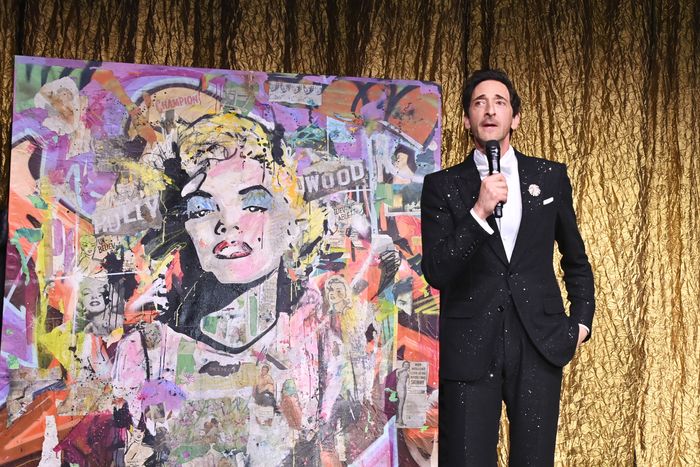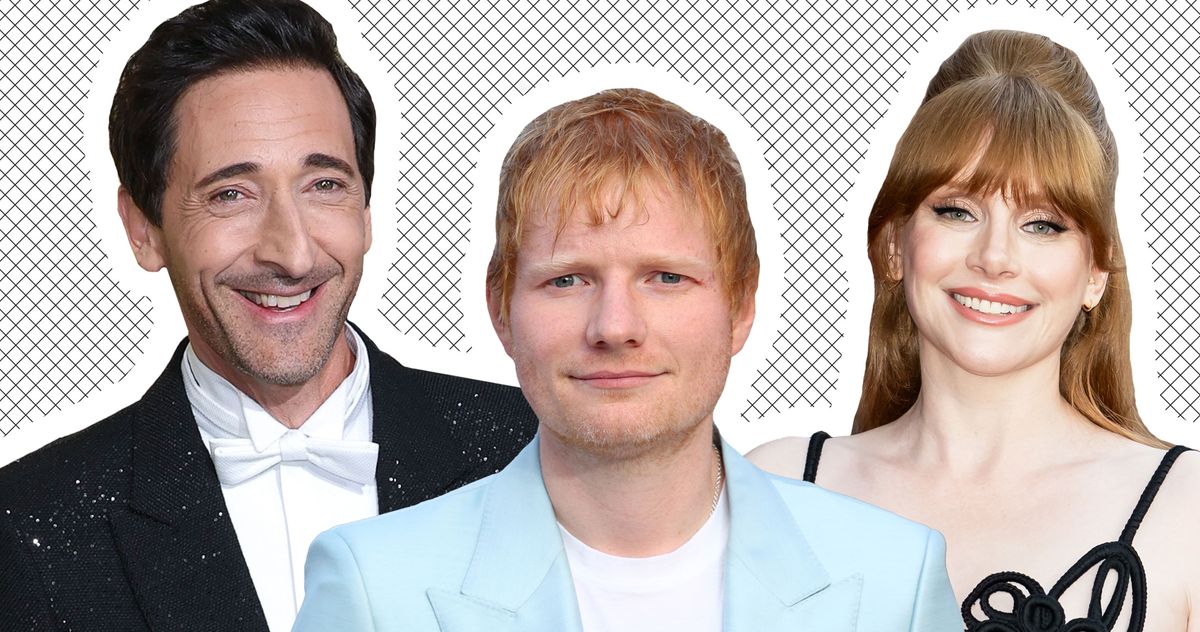
Photo-Illustration: by The Cut; Photos: Getty Images
Something odd is happening in the art world this summer. On top of tourists overcrowding the Louvre and ChatGPT helping Versailles visitors communicate with statues, Adrien Brody, Ed Sheeran, and Bryce Dallas Howard are among the recent celebrities to reveal that they would also like to be recognized as painters. And while the reviews have been less than generous, that doesn’t seem to be stopping them.
In June, Brody opened “Made in America” at the Eden Gallery in Soho. Art News called the works “hideous.” Annie Armstrong wrote, “I can’t stop thinking about how bad this art is,” both an insult and backhanded compliment. Still, the paintings sold, with one reportedly going for $425,000 at Cannes. Brody got a New York Times profile, a gushing Interview Q&A, and the kind of artsy lighting and self-mythologizing that usually comes with being taken seriously. (The Oscar he won earlier this year for his turn in The Brutalist certainly didn’t hurt.)
Sheeran, meanwhile, showed his paintings (abstract splatters in Sheeran-appropriate colors like red and orange) in a London charity exhibition to support music education. The pieces reminded me of the ones you’d see at a suburban pop-up gallery in a co-working space. A Guardian critic described the musician working in a white hazmat suit, “as if paint was radioactive material or sewage,” and dismissed Sheeran’s homage to Pollock.

Photo: Dave Benett/amfAR/Dave Benett/amfAR/Getty Images f
And then there’s Howard, who has taken a slightly more earnest approach to painting. She has been telling interviewers that she’s studying with the Milan Art Institute, an online school that teaches students how to create and sell their art while also summoning what the curriculum calls an “angel army.” (One of the site’s slogans is “You are a culture warrior whose life is the victory that wins the war.”)
I wish I could say that most of the celebrity paintings I’ve come across are interesting, anti-Establishment works of outsider art, but they tend to be aesthetically clumsy, weirdly literal, and derivative. Still, even “bad” art is effective PR when it comes with a story. Brody’s paintings don’t have to be good when they can be framed as emotionally raw, the product of years spent sketching on set, searching for meaning as he Method acted as tortured artists. Sheeran’s blotches become meaningful through charity and repetition. Howard has said that the process of watercolor painting as a hobby helps her manage her mental health. They don’t need expert technique when they have sincerity, a platform, and a decent publicist.
These painting projects might just be creative detours or ways to kill time between jobs. I see them more as carefully staged performances that gesture at transformation. They are easy to mock — and a lot of critics have — but I’m often struck by celebrities who treat painting as a way to express something they don’t quite trust the press or social media to communicate. If interviews are too managed and Instagram too chaotic, maybe a canvas can carry a softer missive. The gallery becomes its own kind of spotlight, and the message is clear: I’ve changed, the celebrity turned artist is telling us. Look again.
The recent move toward painting feels especially common among middle-aged male celebrities, many of whom are in need of an image rehab. Brad Pitt has been sculpting in a studio in L.A. Johnny Depp sells cartoonish portraits of his “Friends & Heroes” (think Al Pacino Pop Art). Jim Carrey made a small career out of Expressionist political paintings during the first Trump administration (he painted mangoes during Joe Biden’s presidency). Sylvester Stallone paints, and Pierce Brosnan does too. Whether their audiences are fully onboard with taking them seriously as artists remains to be seen, but I imagine that once some of these men aged out of doing their own stunts, they decided they would at least try to be known for doing something sensitive with their hands instead.
At the same time, there are a few celebrities who are actually widely considered to be good artists. I asked a chic artist friend to weigh in on Lucy Liu, who has been showing her work under the name Yu Ling for years. Her paintings are composed, bold, and surprisingly technical. The same artist friend also pointed me toward the work of Jemima Kirke, who studied at the Rhode Island School of Design and paints intimate portraits and domestic scenes with a grounded emotional clarity. Of course, she then highlighted David Lynch’s paintings, which are as moody and surreal as you’d expect, and mentioned Dennis Hopper, who was both a documentarian and an artist. She even allowed my secret admission that I like George W. Bush’s paintings, which famously fall somewhere between naïve and unsettlingly profound. We agreed that his self-portrait of his toes in the bath is strangely memorable, even if we are pretty sure he doesn’t realize he’s referencing Frida Kahlo.
Slower than a podcast and more permanent than a tweet, celebrity painting has become a prestige soft launch for reinvention. A show on the wall has gravitas, and even if the work is mediocre, it can signal effort, vulnerability, and a desire to be seen in a different way. Sure, these celebrity exhibitions might be less about the art and more about the narrative the star is shaping about themself. But at least they don’t have to wait for someone else to tell their story when they can hang it on a wall and sell it for half a million dollars. A white-cube gallery is fresher than a press junket, after all.
Stay in touch.
Get the Cut newsletter delivered daily
Vox Media, LLC Terms and Privacy Notice
Related

